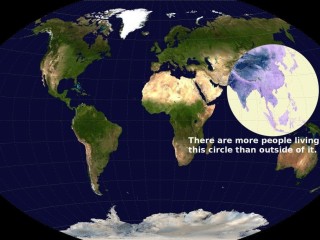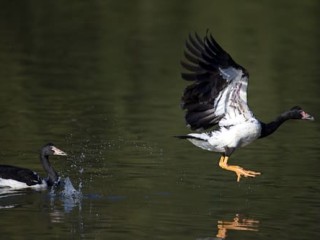Pioneering Kununnurra farmer Rob Boshammer reckons northern cattle producers can learn a thing or two from the magpie geese they see flying in V-formations across the big blue skies of northern Australia at this time of year.
Mr Boshammer was one of several speakers who addressed the Northern Territory Cattlemen’s Association's 30th annual conference in Darwin last Friday, where attentions focused not just on what has been achieved over the past 30 years, but what lies ahead for the next 30.
A leading panel of experts addressed the conference on issues ranging from the long term outlook, northern Australia’s place in the Asian region, the growing expectations of consumers and how the Australian cattle and live export industry can best win the confidence, support and trust of the broader community.
Here are just some of the take home messages they shared at NTCA 2014:
Australia’s future is in Asia
 Look at the map and in particular the area highlighted by the circle. There are more people living inside that circle than outside it. Rabobank’s Thos Gieskes pointed out 71pc of projected growth in global food demand in the next 40 years will occur inside the area covered by the circle. As Mr Gieskes asked the conference: Could Australia’s agricultural export industries be better positioned to supply that demand?
Look at the map and in particular the area highlighted by the circle. There are more people living inside that circle than outside it. Rabobank’s Thos Gieskes pointed out 71pc of projected growth in global food demand in the next 40 years will occur inside the area covered by the circle. As Mr Gieskes asked the conference: Could Australia’s agricultural export industries be better positioned to supply that demand?
Focus on value, not volume
Higher incomes and the continuing trend towards urbanisation is causing dietary patterns throughout Asia to change. Dr Caroline Hong said Australia should not focus on trying to become the food bowl of Asia, supplying low cost food to billions of Asian customers, but rather by becoming the ‘delicatessen’ of Asia, supplying premium food to the millions of middle class consumers in Asia. "it is about our quality, safety and our food is tasty, that is what we compete on,” she said.
Sell the Australian beef story
Rabo’s Thos Gieskes agreed that Australia’s beef industry should target value over volume. But to do that, it had to tell a story. “A differentiated product will be demanded, there will be income backing that from people wanting something else, but you have to sell them what you have on offer,” he said. “And not so much what you have, but why you have it in the shape that you have it.” He said consumers would be attracted to brands and stories about health, safety, and flavour. “The story will be vital to get the value out. Without the story, you’re like everybody else and probably more expensive.”
Follow NZ’s lead
What New Zealand has achieved in building a trusted global brand and telling a story to consumers has been nothing short of “phenomenal”, Mr Gieskes said. “On one hand, it has presented itself as a country label, which has really put the country NZ on the map. And then the next step for any kind of product coming out of NZ is already a lot easier.” NZ companies had also developed successful joint ventures with customers directly in Asia to the mutual benefit of both. For example the JV between NZ meat processor/exporter Alliance and Chinese meat importer/processor/retail brand Grand Farm, had provided Alliance with specific knowledge about what Chinese consumers wanted, and had helped Grand Farm to demonstrate the safety of its product to consumers. The NZ Merino brand had also successfully used images of natural surroundings to tell a story to consumers explaining why they should use natural fibres over man-made synthetics. Economist Dr Andy Stoeckel also added that an element of generic promotion was essential alongside individual brand promotion to underpin a broad, positive message to consumers.
Don’t pretend the negatives don't exist
Reputations are formed not just by what is positive, but also what is negative. And often, as public relations strategist Katherine Teh White explained, people, companies and industries are remembered only for the things they would rather not be remembered for. When the average Australian was asked about the live export industry, Ms Teh White said they thought about what they saw on Four Corners in Jakarta. “That was a turning point because it seemed to sum up what the live export industry was about, and yet it doesn’t,” she said. To improve its reputation and to maintain its ‘social license’ to operate, she said the industry must assess its weaknesses at every point in the supply chain, admit its mistakes and continually work to ensure it is meeting the Australian community’s changing expectations. “To do it, you don’t pretend things didn’t happen. You don’t build a reputation just from the positives. You build your reputation from how you dealt with your negatives.” International standards expert David Horlock, the managing director of the British Standards Institution (BSI) Asia Pacific, also discussed the need for Australia's cattle industry to work harder at understanding its hidden supply chain risks and to communicate the good story it already has to tell. “When your train crash happens and you can’t defend yourself and tell your supply chain story, what happens is that someone else will tell it for you, and they wont talk about the good stuff, they will talk about the bad stuff.”
Don’t put all your eggs (or beef) into China’s basket
There is plenty of good news in China for Australia’s beef industry, based on a booming middle class that is demanding more protein and China's heavy reliance on imports to satisfy that demand. However, as economist Dr Andy Stoeckel told the audience, despite its amazing story of recent economic growth, China is not without its challenges. Around two-thirds of China’s GDP comes from debt-fuelled investment borrowed by provincial Governments and state-owned enterprises, as opposed to consumption. That investment is growing at 20pc per annum, well above China’s overall economic growth rate of 7.5pc per annum. Dr Stockel said Chinese authorities had allowed the exchange rate to appreciate in order to try to arrest the emphasis on investment and encourage more consumption, which had seen the effective exchange rate in rise by 40pc since 2006. The ratio of old people to young people in China’s population was also rising as a result of the one-child policy, adding further weight to the view that China’s growth was not sustainable and that an economic slowdown at some point cannot be avoided. The main question was when that would occur and whether it can be managed smoothly.
Our real competition is at home
While Australia’s beef industry will continue to face strong export competition from countries such as Brazil, the US and India, economist Dr Andy Stoeckel said Australia’s ‘real’ competition was actually closer to home. “Your real competition is in the resource sector,” he said. “There has been a huge hollowing out in Australia. What you have to do is to make better use of all those resources that you need to produce better beef. If you are out there mustering with a helicopter, you have to be able to pay the rate to afford that helicopter which is going to be partly determined by the rate they can go along and take some core samples back to the mining company. So the ultimate competition is can you make better use of the resources available in society than anybody else.” Dr Stoeckel said there were signs resources industry competition was ‘coming off the boil’, however, with one half of Australian coal producers fundamentally uneconomic at the prevailing coal price of $82 a tonne. “So resources are about to switch back into traditional exports like agriculture and so on around the economy,” he said.
Why its hard to compare cattle prices between countries
In the past year cattle prices in the US have increased by 24pc and in Brazil by 20pc. Why have Australian cattle prices missed the global cattle price party? MLA chief economist Tim McCrae told the NTCA conference that while drought-induced supply factors have clearly restricted returns for producers in Australia in the past year, the US and Brazil both also have the benefit of massive domestic markets. “Why it is always dangerous to compare Australia against those counties is that 90-95pc of all the cattle and beef produced in the US is transacted with no currency or market access issues, and 80-85pc in Brazil. Let’s say about 33pc of the beef we produce in Australia is cleared (into our domestic market) with no currency or market access constraints. Other than that, everything that is produced faces those two big volatile barriers to trade (currency and market access issues)”.
What producers can learn from magpie geese
Rob Boshammer is one of the most successful primary producers in Northern Australia, a farmer who has pioneered the development of numerous crops in the Ord River irrigation area in north western WA including the increasingly popular Chia. Mr Boshammer shared several practical business lessons he has learned during 30 years in the Ord, before he closed with a story about magpie geese, which he used to encourage more producers to share the burden of industry representation. “One of my inspirations as I go around especially in this country at this time of year, is the magpie geese flying around. I don’t know if you realise it but in that formation, they have done some studies on it, flying in that V-formation with one flying in the lead and taking turns at the lead, they save about 30pc of their energy. Thank goodness we have got good people taking the lead. Luke (Bowen) has been leading for a while, the NTCA has been leading fairly well, but other people have to take over… the executive should be renewed regularly, otherwise they get worn out, we have got to maintain that 30pc gain in efficiency.”
Click on images below to view in larger format




HAVE YOUR SAY